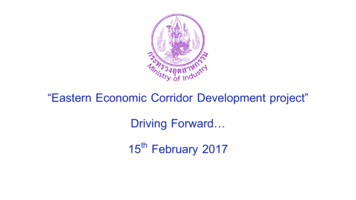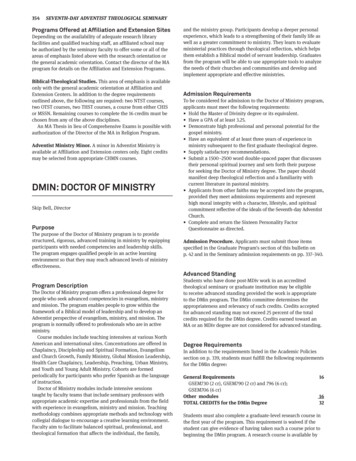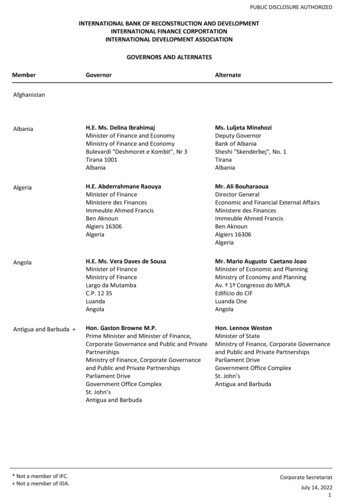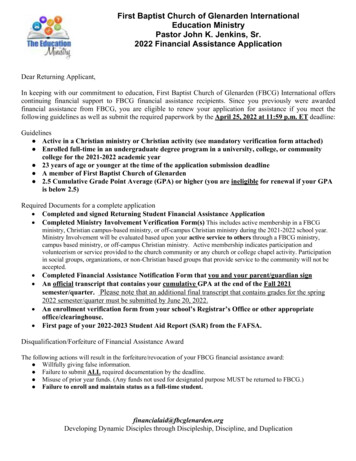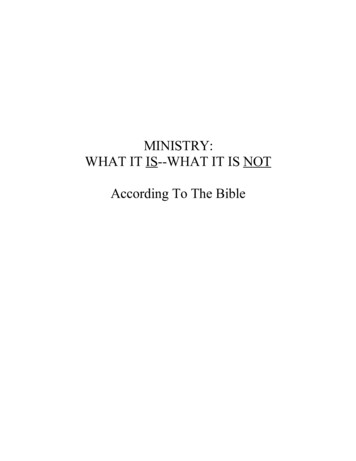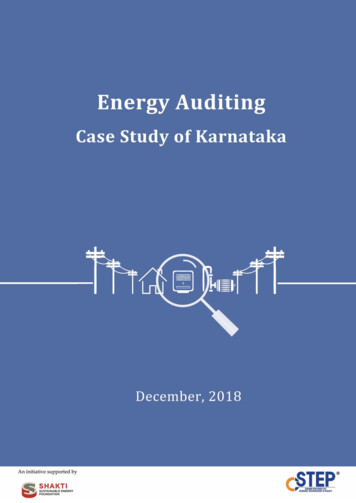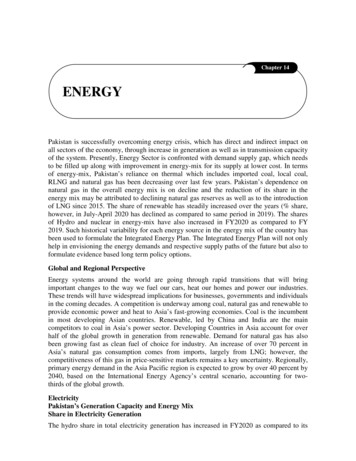
Transcription
Chapter 14ENERGYPakistan is successfully overcoming energy crisis, which has direct and indirect impact onall sectors of the economy, through increase in generation as well as in transmission capacityof the system. Presently, Energy Sector is confronted with demand supply gap, which needsto be filled up along with improvement in energy-mix for its supply at lower cost. In termsof energy-mix, Pakistan’s reliance on thermal which includes imported coal, local coal,RLNG and natural gas has been decreasing over last few years. Pakistan’s dependence onnatural gas in the overall energy mix is on decline and the reduction of its share in theenergy mix may be attributed to declining natural gas reserves as well as to the introductionof LNG since 2015. The share of renewable has steadily increased over the years (% share,however, in July-April 2020 has declined as compared to same period in 2019). The sharesof Hydro and nuclear in energy-mix have also increased in FY2020 as compared to FY2019. Such historical variability for each energy source in the energy mix of the country hasbeen used to formulate the Integrated Energy Plan. The Integrated Energy Plan will not onlyhelp in envisioning the energy demands and respective supply paths of the future but also toformulate evidence based long term policy options.Global and Regional PerspectiveEnergy systems around the world are going through rapid transitions that will bringimportant changes to the way we fuel our cars, heat our homes and power our industries.These trends will have widespread implications for businesses, governments and individualsin the coming decades. A competition is underway among coal, natural gas and renewable toprovide economic power and heat to Asia’s fast-growing economies. Coal is the incumbentin most developing Asian countries. Renewable, led by China and India are the maincompetitors to coal in Asia’s power sector. Developing Countries in Asia account for overhalf of the global growth in generation from renewable. Demand for natural gas has alsobeen growing fast as clean fuel of choice for industry. An increase of over 70 percent inAsia’s natural gas consumption comes from imports, largely from LNG; however, thecompetitiveness of this gas in price-sensitive markets remains a key uncertainty. Regionally,primary energy demand in the Asia Pacific region is expected to grow by over 40 percent by2040, based on the International Energy Agency’s central scenario, accounting for twothirds of the global growth.ElectricityPakistan’s Generation Capacity and Energy MixShare in Electricity GenerationThe hydro share in total electricity generation has increased in FY2020 as compared to its
Pakistan Economic Survey 20192019-20share in FY2019. Currently, thermal has the largest share in electricity generation. Gas andRLNG are other cheaper sources. Significant growth of RLNG usage in energy mix hashelped in improved supply to various power plants like Bhikki, Haveli Bahadur Shah,Balloki, Halmore, Orient, Rousch, KAPCO, Saif and SapphirSapphire.e. Moreover, RLNG is alsobeing supplied to fertilizer plants, industrial and transport sectors. The comparison of shareof different sources of electricity generation is given below:Table 14.1: Share in Electricity Generation ource: Ministry of Energy, (Power Division)% Share 2019(Jul-Apr)% Share 70516297049205796382FigFig-14.1: Share in Electricity Generation (%)802019 (Jul-Apr)(Jul63.0604058.42020 hermalTable 14.2: Installed apacity(MW)33,45235,972Source: Ministry of Energy, (Power Division)Till April, FY2020, installed capacity ofelectricity has reached to 35,972 MW, whichwas 33,452 MW in April 2019, posting agrowth of 7.5 percentNuclearRenewableFig-14.2:14.2: Installed Capacity 20002018-19(Jul-Apr)2019-20(Jul-Apr)Electricity ConsumptionRegarding consumption pattern, there is no significant change in the consumption pattern ofelectricity. However, during JulyJuly-April FY2020, the share of agriculture in electricityconsumption has been decreasing which may be attributed to improved rain pattern formajor crops. Thehe share of Household in electricity consumption has increased. Thecomparison between consumption patterns oof electricity during March 2020 withcorresponding period last year is shown below:274
EnergyTable 14.3: Share in Electricity ConsumptionDescription/ Sectors UNITS SOLD nd Total5,727,040UNITS SOLD 5,113,567% ShareMar-1938.077.1234.3410.589.90100.00% ShareMar-2044.907.7229.458.049.88100.00Oil SectorThe consumption of petroleum products (energyproducts) in Pakistan is 19.68 milliontonnes/annum/annum against the supply of 11.59 milliontonness per annum from local refineries, while restof the 8.09 million tonnetonnes/annum is beingimported.Fig-14.3:14.3: Share in Electricity 9OthersAgricultureIndustryCommercialHouseholdOil prices have crashedashed and lost over 60 percent of1110 1087 8its values in last few months owing largely to nonnonagreement between OPEC and nonnon-OPEC majorcrude producers on cutting world production andthe sharp decline in demand due to closing downon industries, tourism and servicservice sectors acrossthe world due to COVID-1919 pandemic. FFor thefirst time in history, thehe settlement price for WTIcrude on 20-04-2020 was negative 40.0; however international bench mark i.e. Brent crudeplunged to 22 /barrel/barrel and recovered to 30 /barrel during 2nd week of May 2020.The Government of Pakistan has shared the benefits of lower petroleum with the populationby reducing petroleum prices frequently in the recent past; the government has reduced theprices of various petroleum products ranging from Rs 15 to Rs 30 on May 1, 2020. Earlier,the petroleum products prices were decreased by Rs 7 per liter for the month of March andsubsequently, Rs 15 per liter in April. Pakistan imports 15- 16 billionn worth of oil annuallyand in the current scenario,, the Government can save up to 8- 9 billion. Iff the governmentpasses 50 to 60 percent of the benefit of the drop in oil rates to the public, it may generatesizable economic stimulus.The total refiningg capacity of the country is 19.37 million tonnes;s; however, the same is notbeing fully utilized on account of financial as well as technical problems. On financial side,the present Government after taking over, made concerted efforts to clear the circularcircula debt,however, the same continued to rise. The government is engaged with IMF and World Bankto address it appropriately, to ease down the liquidity problem.On the other side, most of the refineries in Pakistan are old version except PARCO. Suchrefineriesies produce more than 40 percent of Furnace Oil (FO), which is the lowest price valueproduct. A refinery producing large quantities of FO is generally a money loser or hassqueezed margins based on the pure crude/product price differential.275
Pakistan Economic Survey 2019-20The Petrol consumption in the country is 7.6 million tonnes/annum, out of which 30 percentis being catered from local refineries and rest is being imported to meet the NationalDemand. Similarly, the consumption of Diesel is around 7.3 million tonnes/annum. Thelocal production can meet 65 percent of the total demand, while rest is being imported.At refining side, five refineries namely; PARCO, NRL, PRL, APL and Byco are operatingin the country. Byco leads with major share in installed capacity by 38 percent followed byPARCO and NRL by 23 percent, 15 percent respectively. Whereas, APL and PRL possess13 percent and 11 percent share respectively in domestic installed capacity.Table 14.4: Detail of Oil RefineriesS. No.Name of RefineryCapacityArea100,000 bbl/dMultan1.Pak Arab Refinery Limited (MCR)2.Attock Refinery Limited (ARL)53,400bbl/dRawalpindi3.Byco Petroleum Pakistan Ltd (Byco)150,000bbl/dHub Balochistan4.National Refinery Limited (NRL)64,000bbl/dKarachi5.Pakistan Refinery Limited (PRL)50,000bbl/dKarachiThere are thirty Oil Marketing Companies (OMCs), in the Country, major are; PakistanState Oil Company Limited (PSOCL), Shell Pakistan Limited (SPL), Total Parco PakistanLimited (TPPL), Attock Petroleum Limited (APL), Gas & Oil Pakistan Private Limited(GOPPL) and Hascol Storage Limited (HPL, Among these OMCs, PSO leads with anoverall market share of 42.5 percent, followed by APL with 10.9 percent, TPPL 10.3percent, HPL 9.8 percent and SPL 8.3 percent.OMCs receive, store, distribute / market the petroleum products in the Country by utilizingtheir supply arrangements and infrastructure, comprising of OMC’s Installations, StorageDepots, Oil Pipelines and Retail Outlets, etc. The bulk of 19.68 million tonnes of petroleumproducts required by the Pakistan’s market is transported by Road (around 74 percent), Oilpipelines (24.4 percent) and Railways (1.5 percent). The OMCs (i.e. PSO, SPL and TPPL)hold equity partnerships in the White Oil Pipeline (WOP), which provides the strategicinfrastructure to transport petroleum products from Karachi to the Up-Country locations.WOP has a transportation capacity of 12 million tonnes / annum.There are around 8567 OMC’s Retail Outlets in the Country. PSO has the largest share ofaround 3,487 Retail Outlets, Moreover, the OMCs are managing a fleet of more than 12,000tank lorries for the movement / supply of the petroleum products.Gas SectorNatural Gas is a clean, safe, efficient and environment friendly fuel. Its indigenous suppliescontribute about 38 percent in total primary energy supply mix of the country. Pakistanproduces around four (4) Billion Cubic Feet Per Day (Bcfd) of indigenous natural gasagainst an unconstrained demand of over six (6) Bcfd. To meet the shortfall, the GoP hasinitiated the import of LNG. Pakistan has an extensive gas network of over 12,971 KmTransmission 139,827 KM Distribution and 37,058 Services gas pipelines to cater therequirement of more than 9.6 million consumers across the country. Government of276
EnergyPakistan is pursuing its policies for enhancing indigenous gas production as well as importedgas to meet the increasing demand of energy in the country. At present, the capacity of twoFloating Storage and Re-gasification Unit (FRSU) to Re-gasified Liquefied Natural Gas(RLNG) is 1200 MMCFD and accordingly RLNG is being imported to mitigate gasdemand-supply shortfall.LPG plays an important role in the energy mix of Pakistan as it provides a cleaneralternative to biomass-based sources, especially in locations where natural gas is notavailable. It an emerging sector of energy in Pakistan and OGRA is empowered to regulatethe LPG sector under the OGRA Ordinance, 2002 and LPG (Production & Distribution)Rules, 2001 w.e.f. 15th March, 2003. The total supply of LPG during July-March 2019-20was 739,785 Metric Ton. Currently, there are 11 LPG producers and 200 LPG marketingcompanies operating in the country having more than 7,000 authorized LPG distributors.OGRA has simplified the procedure for grant of LPG license and the same is granted on fasttrack basis once the requirements are met / complied. During July-March 2019-20, one (01)operational license of LPG Storage Terminal, three (03) licenses for construction of LPGAir-Mix plant, thirty-five (35) licenses for construction of LPG Storage & Filling plants andeighteen (18) licenses for operation of LPG Storage & Filling plants were issued. Inaddition, OGRA has also issued three (03) licenses for construction of LPG Auto Refuelingstations and three (03) operational licenses for LPG auto refueling stations during the sameperiod.Due to augmented investment and future expansion plans of the LPG marketing companies,significant investment in LPG supply and distribution infrastructure has been witnessed.LPG sector has also provided jobs to hundreds of unemployed people. During July-March2019-20, an investment of Rs 3.72 billion approximately has been made in LPGinfrastructure.Around 76 percent of the LPG consumed is met with Local Production in Pakistan, whereasthe rest is imported. Refineries, Gas Producing Fields and Imports are three main sources ofLPG supply in the Country. LPG is gradually becoming popular domestic fuel amongpeople who live in far-flung areas and where natural gas infrastructure does not exist.Currently, LPG accounts for about 1.2 percent of the total primary energy supply in thecountry. This low share of LPG in the total energy mix is mainly due to supply constraintsand the higher price of LPG in relation to competing fuels like natural gas, wood etc.The current size of LPG market is around 1,061,447 MT/Annum. It is primarily meant tosupply for the domestic fuel requirement especially in natural gas starved areas and in peaktimes in the urban territories. The use of LPG as domestic fuel shall deter deforestation inhilly areas and shall provide a comparatively healthier and hygienically safe alternative tothe common citizens. GoP has taken a policy decision to allow use of LPG in the automotivesector to share the burden with conventional auto fuels. Subsequently, OGRA has laid downan elaborated regulatory framework for supply of LPG to the vehicles.From 2008 onwards, OGRA started registration of LPG equipment manufacturingcompanies for the purpose to eradicate substandard manufacturing, sale and use of LPGequipments. Till March 2020, OGRA has pre-qualified 52 LPG equipment manufacturingcompanies as authorized manufacturer of LPG equipment.277
Pakistan Economic Survey 20192019-20Table 14.5: LPG Regional/Sectoral Consumption during FY2019 &&FY2020Sectors/ Regions2018-192019-20Domestic Commercial IndustrialTotalDomestic Commercial IndustrialFederal 5206,306Northern 14,088560Annual (Ton)445,496415,368200,583 1,061,447322,779348,51898,292Daily (Ton)1,2211,1385502,9081,1741,267357(Source: LPG Marketing Companies 26,08748,142769,5892,799Fig-14.4:14.4: Sectoral Consumption of LPG 20000010000003300Annual (Tonnes)Daily esticTotalFig-14.5: Regional LPG 21200,00028,714300,00081,286400,0000Federal Capital AreaPunjabSindhKPBaluchistanNorthern AreaFATAAJKCurrently, LPG supplies are being met through three sources: refineries, gas producingfields and imports. The actual supply from refineries/producing fields is presented infollowing table and the respective share of each supply source in the total country-widecountrysupply is shown in figure belowbelow.Table 14.6: LPG Supply during FY2019 & FY2020Sectors2018-19Annual (Ton)Daily (Ton)Attock Refinery Limited2,8468Pakistan Refinery Limited16,06544National Refinery Limited8,613242782019-202019Annual (Ton)Daily (Ton)3,1181110,355385,11319
EnergyTable 14.6: LPG Supply during FY2019 & FY2020Sectors2018-19Annual (Ton)Daily (Ton)Pak Arab Refinery Company120,773331Byco Petroleum53,025145Refineries Sub Total201,322552OGDCL267,181732UEPL (Naimat Basal) formerly BP24,40067OPI (Ratna, Ex-Meyal)2,1686JJVL26,60973POL (Mayal-Pindhori)15,92044PPL94,324258MOL Pakistan176,507484Fields Sub Total607,1081,663Total Production (M.T)808,4312,215LPG Import (M.T)252,467692Total Production Import (M.T)1,060,8972,907Source: LPG monthly production reports of producers2019-202019Annual (Ton)Daily 127144382354981,5742,0267192,746Fig-14.6: LPG Supply 4,512100,000RefineriesFieldsLPG Import (M.T)Table 14.7 Status of all LNG projectsTabeer Energy (Private) Provisional License timelines extended till August 2020.Limited TEPL With respect to the application for Construction License by TEPL, in housereview has been done by OGRA. TEPL has submitted response to theshortcomings identified by OGRA and PrePre-qualifiedqualified consultants have beenasked to submit financial bids for evaluation of construction licenseapplication.Energas Terminal (Pvt.)Limited Company has been granted extension in Provisional License to file applicationfor Construction License during last quarter of FY2020.PGP ConsortiumLimited PGPCL The LNG terminal is operational and no application is pending w.r.t instantproject. Compliance of License Conditions is regularly sought from thecompany.Source: OGRA279
Pakistan Economic Survey 2019-20Table 14.8: LNG Terminals in Pakistan:S#Company NameCompany LocationTerminalLocationPort Qasim1SSGC LPG(Pvt.)LimitedSSGC GTI Building, Karachi, Terminal, Opposite SafariPark, Main University Road, Karachi.2ENGRO VopakLimited4th Floor, Office Number 05, Dolmen City, HC# 03, Block04, Scheme 05, Clifton, Karachi.Port Qasim3Al-Qasim Gas(Pvt.) LimitedOffice No. 04, 1st Floor, Safdar Mansion, Fazl-e-Haq Road,Blue Area, Islamabad.Gwadar PortSource: OGRANuclear EnergyPakistan Atomic Energy Commission (PAEC) is the sole department in Pakistan engaged inelectricity generation using nuclear technology. There are five nuclear power plantsoperating on two sites in the country, one unit namely, Karachi Nuclear Power Plant(KANUPP) at Karachi and four units of Chashma Nuclear Power Plants (C-I, C-2, C-3 &C-4) at Chashma (Mianwali District of Punjab Province). The gross capacity of these fivenuclear power plants is 1430 MW that supplied about 7,143 million units of electricity to thenational grid during 1st July 2019 to 31st March 2020.KANUPP, the oldest of the lot has surpassed its design life of 30 years and has, in fact,completed 48 years of safe and successful operation. The four units of Chashma are amongstthe best performing electricity generating plants in the country, in terms of endurance andavailability. Some performance parameters of these plants are presented in following table:Table 14.9: PAEC’s Performance ParametersPlantCapacity (MW)GrossNetKANUPPC-1C-2C-3C-4TotalSource: ty sent to Grid (Million KWH)1st July 2019 toLifetime upto31st March 202031st March 5,9077,14387,859Two more units with a total output of 2200 MW are currently under construction near theKANUPP site in Karachi, the Karachi Nuclear Power Plants (K-2 and K-3). First concrete ofK-2 was poured on the 20th of August 2015 and that of K-3 on the 31st of May 2016.Construction of K-2/K-3 is on full swing and is in its final stages with more than half of civilwork already in place. Functional tests of different modules of K-2 are expected to startfrom March 2020 and the plant is likely to connect to the grid by the end of year. PAEC hasundertaken construction of another nuclear power plant at Chashma near Mianwali. The sitealready is home to four operating nuclear plants. This unit will be called C-5 and it willreplicate the design characteristics of K-2 and K-3. A contract for its construction has been280
Energysigned with China and extensive studies for site evaluation are currently underway.PAEC has intensified its activities to meet the nuclear electricity generation target of 8,800MW by the year 2030 set through government's Energy Security Plan formulated in 2005.Completion of K-2/K-3 project will be a big step that will bring PAEC 2200 MW closer toachieving this target. PAEC is planning to develop additional sites to house more nuclearpower plants in the future and sites identified throughout the country. These sites are beinginvestigated and acquired for development.Ample technical and engineering infrastructure is already in place to support both theexisting and the under construction nuclear power plants. Skilled manpower is beingproduced regularly by Indigenous institutes, imparting state of the art training and educationin all relevant disciplines and at all levels, from technical trainings to academic programs.These instruments are enough to successfully support the foreseeable future ambitionsenvisioned by PAEC for the future nuclear power program of Pakistan.CoalMassive energy resource in shape of coal exists in the country and further exploration indifferent areas is in progress but only a fraction of it is being utilized. In coming years, localcoal use should be promoted to achieve larger contribution. Many coal mining and powergeneration projects are in process of development in Thar coal field. Imported coal powerplants may also be required to consider mixing with Thar Coal. Spontaneous combustion is apotential problem for long distance transportation and long-term storage, and thus restrictsThar coal usage. A number of plants on imported coal have now started functioning like onein Sahiwal, two in port Qasim and one plant on indigenous coal has also started operationsin Thar.The volume of import cargo during July-December 2019 stood at 21.878 million tonnes, asagainst the 20.125 million tonnes handled during corresponding period last year, showing anincrease of 8.7 percent. The major non-containerized imports were Coal, LNG, POL,Chemicals, Palm oil and Grain. The Coal imports were the largest imported cargo whichrepresented over 34 percent of total import cargo.Renewable/ Clean EnergyThe Government of Pakistan is emphasizing on utilization of indigenous andenvironmentally clean energy generation resources. In this regard, the promotion ofalternative and renewable technologies is amongst the top priorities of the Government.Several initiatives have been taken to create a conducive environment for the sustainablegrowth of the clean energy sector in Pakistan in order to harness the potential of indigenousrenewable energy resources.Renewable SectorAlternative Energy Development BoardThe development of Alternative and Renewable Energy (ARE) Sector was initiated under aphased, evolutionary approach constituting a strategic policy implementation roadmap underPolicy for Development of Renewable Energy for Power Generation, 2006 (RE Policy2006). The aim was to increase the deployment of alternate renewable energy ARE281
Pakistan Economic Survey 2019-20technologies (ARETs) in Pakistan. The Government of Pakistan is proactively pursuing theexploitation and utilization of its indigenous power generation resources as a part of itsvision in order to achieve strategic objectives of energy security, decreasing dependence onimported fuels and providing sustainable energy supplies for economic growth. Thedevelopment of renewable energy based power generation projects is being pursued on IPPmode through private sector investors. ARE promises a higher proportion of the nationalenergy supply mix and helps ensure universal and affordable access to electricity in allregions of the country.Several ARE projects, initiated under the RE Policy 2006, were not able to proceed withtheir development due to restrictions imposed vide decisions taken by CCOE dated 12thDecember, 2017. Under the vision of the current Government to exploit clean energyresources and increase the share of ARE in the energy mix, the CCOE vide its decisions incase No. CCE-12/04/2019(V) dated February 27, 2019 allowed implementation of projectsthat had already achieved significant milestones of project development by placing theminto following three categories;Category-1:19 projects of 531 MW that have already been issued Letter ofSupport (LOS) subject to revision of tariff in case tariff determination has been donesince more than one year or if the tariff validity period has lapsedCategory-II:22 projects of 1199.3 MW that have acquired tariff and generationlicense subject to revision of tariff in case tariff determination has been done since morethan one year or if the tariff validity period has lapsedCategory-III:104 projects of more than 6000 MW cumulative capacity holdingLOIs to be allowed to proceed ahead after becoming successful in a competitive biddingto be undertaken as per demand communicated by NTDC.In compliance of the CCOE’s decision, AEDB has actively been facilitating the said projectsas per the criterion set by the CCOE. Twelve (12) wind power projects with a cumulativecapacity of 610 MW have been facilitated to successfully achieve Financial Closing inNovember, 2019.AEDB is also in process of formulation of RFP package for carrying out competitivebidding for projects falling under category-III. AEDB carried out consultative workshops on27th and 29th November, 2019 on the draft RFP package for seeking inputs from all relevantstakeholders. The RFP package is under submission to NEPRA for approval.New Alternative & Renewable Energy PolicyA new Alternative & Renewable Energy Policy (ARE Policy 2019) has been formulatedconsequent to expiry of RE Policy 2006 in March, 2018. The policy aims at creating aconducive environment supported by a robust framework for the sustainable growth of ARESector in Pakistan. The GOP’s strategic objectives of affordability of electricity, energysecurity, availability for all, environmental protection, sustainable development, socialequity and mitigation of climate change will further be harnessed under the ARE Policy2019. Salient features of the new ARE Policy 2019 are as follows:282
EnergyThe policy has an expanded scope encompassing all alternative and renewable energysources, competitive procurement and addresses areas like distributed generationsystems, off-grid solutions, B2B methodologies and rural energy services.ARE Policy 2019 envisages development of large scale ARE projects in all parts of thecountry through active participation of the provinces.Provinces are also part of the Steering Committee envisaged in the policy that will becarrying out the planning of ARE induction. Provincial energy departments will becarrying out competitive bidding process as per the annual ARE procurement planapproved by the AEDB Board on recommendations of the Steering Committee.The most significant feature of the policy is that it makes a transition from the traditionalmethods of procurement based on cost plus and upfront tariffs to competitive bidding.All new RE projects specifically wind and solar power projects will be developedthrough competitive bidding.ARE Utilization & DistributionApart from large scale RE projects, the Government of Pakistan is also encouragingutilization of renewable energy technology at consumer ends across domestic, commercialand industrial sectors. Moreover, off-grid RE applications for village electrificationrequirements are also being promoted. Different activities under the following initiativeswere carried out during the FY2020;i. Net-MeteringIn order to maximize the utilization of ARE technologies, NEPRA had announced NEPRA(Alternative & Renewable Energy) Distributed Generation and Net Metering Regulations,2015 on September 1, 2015. These regulations provide the framework for implementing netmetering installations using solar and wind generation of up to 1 MW capacity. The first netmetering system of 1 MW capacity was installed at the Parliament House, Islamabad whichhas opened the door for net-metering based systems in all parts of the country.During the period of July 2019 to March, 2020 more than 2300 new licenses were issued byNEPRA for net-metering based installation of approx. 34 MW. As of March, 2020 morethan 4125 solar installations with a cumulative capacity exceeding 75 MW have beenapproved by NEPRA for net-metering.ii. IFC Lighting PakistanAEDB with the support of IFC completed a four year program for creating awareness andbringing private sector investment in remote villages in Pakistan. The program successfullyintroduced IFC Global Standard products in off-grid villages in Sind Gilgit-Baltistan andPunjab. The program was aimed to address the lighting needs of consumers and give accessto low-cost, high-quality, safe, reliable, and cleaner lighting products.iii. RBF Off-Grid Electrification Pilot ProjectAEDB undertook a pilot Result Based Financing (RBF) off-grid electrification initiative.283
Pakistan Economic Survey 2019-20The project was executed in remote areas of Sindh and Punjab. The project resulted ininviting private sector companies to develop their businesses-cum-supply chain for off-gridsolar solutions in the remote villages. The pilot project was completed in December 2019,which is expected to lead to full fledge programme in next year.Initiatives Taken by AEDB for Development of ARE SectorAEDB undertook a number of supportive measures in order to promote ARE technologiesand to attract private sector investments. Some of the supportive measures taken by AEDBare as follows:i. AEDB assisted State Bank of Pakistan in revision of SBP’s Financing Scheme forRenewable Energy in order to make financing available for broader consumer categoriesand swift implementation. The facility has been extended till June, 2022. So far, sixcommercial banks namely JS Bank, Bank of Khyber, Habib Bank, Faysal Bank, MeezanBank and Bank Alfalah already have announced their products under the SBP facility.ii. Assisted World Bank in study for analyzing the integration of variable renewable energyin the nati
in the country. Byco leads with major share in installed capacity by 38 percent followed by PARCO and NRL by 23 percent, 15 percent respectively. Whereas, APL and PRL possess 13 percent and 11 percent share respectively in domestic installed capacity. Table 14.4: Detail of Oil Refineries S. No. Name of Refinery Capacity Area 1.
